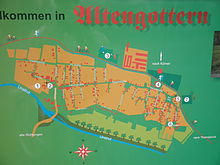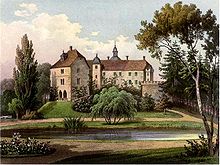Altengottern
|
Altengottern
Rural community of Unstrut-Hainich
Coordinates: 51 ° 9 ′ 51 ″ N , 10 ° 34 ′ 59 ″ E
|
|
|---|---|
| Height : | 175 m above sea level NHN |
| Area : | 18.33 km² |
| Residents : | 1017 (December 31, 2017) |
| Population density : | 55 inhabitants / km² |
| Incorporation : | 1st January 2019 |
| Postal code : | 99991 |
| Area code : | 036022 |

Altengottern is a district of the rural community Unstrut-Hainich in the Unstrut-Hainich district in Thuringia .
geography
The village of Altengottern lies along the Unstrut between Mühlhausen and Bad Langensalza . The district of Altengottern extends north of the Unstrut to the old Heerstraße between Bollstedt and Bothenheilingen . The Roter Berg ridge protrudes prominently from the landscape.
history
Altengottern was already a settlement of the Hermunduren , which originated in the originally marshy valley of the Unstrut. The place developed from two settlement centers - today referred to as the upper and lower village. So far, 997 has been assumed to be the year of the first written mention of the place as Aldengudeno . Recent studies on the first mention of the place show the dating 802–817.
It is assumed that there was also a royal court of Emperor Heinrich II in Altengottern , because his presence in the place was recorded in 1017. A moated castle was probably already standing on the Unstrut at this time, directly on the site of the later manor in the western district, in order to secure the road across the river. From 1155 Ekkehardt is mentioned in documents by Gottern, who probably had his seat in the moated castle as a feudal man . From 1180 to 1316 the Lords of Gods are named as owners of the castle. From 1440 it was the Lords of Hagen. In 1632 Rudolph Levin Marschall von Herrengosserstedt married the heiress Anna Gertrud von Hagen. In 1641 the village and castle Altengottern were victims of the Thirty Years' War . The marshals, like the other surviving local residents, were evicted. Reconstruction and resettlement began in 1650. The farmers were given enough property of their own, so that soon there was some prosperity in the village again. The middle part of the castle and the churches of St. Trinitatis in the upper village (instead of the previous church of St. Martin) and St. Wigberti in the lower village, donated by the sons of Rudolf Levin, date from the reconstruction period that lasted until 1700. Local builders and artists were brought in. Around 1790, two Marschall brothers shared the estate. In 1824 Carl Friedrich Adolf von Marschall had the classicist half-timbered building of the manor house built on Rittergut II. From 1820 to 1824 the north wing of the old castle was renewed in the Romanesque style. The small park was redesigned and the library added. In 1903 additions were made to the castle. The cellar vaults in the castle certainly date from the time of the moated castle.
The proximity to the river Unstrut was associated with devastating floods for the place. As early as 1670, Rudolf Levin von Marschall had the first protective dam built. From February 22nd to 23rd, 1799, a devastating flood of the Unstrut is reported, which occurred as a result of ice dislocations and caused great damage to the place. A high water mark on the village church testifies to the event. Under Baron Wolf Marschall von Altengottern as the Prussian district administrator, the Unstrut was regulated at the end of the 19th century.
Altengottern belonged to the Electoral Saxon Office of Langensalza until 1815 and, after its cession to Prussia, from 1816 to 1944 to the district of Langensalza in the province of Saxony . From July 1945 Altengottern belonged to the Soviet occupation zone and from 1949 to the GDR.
After detachment of the American occupation by the Red Army , the family marshal was expelled from the castle lived, then scattered in the village and was sold on December 22, 1945, from there - on pain of admission to a special camp of the NKVD . The entire interior of the castle was removed, the valuable library destroyed, and most of the furniture and pictures destroyed. Today the castle is used as a curative educational home for children and young people. Manor II became a primary school and was demolished in 2007. After 1990, the Marschall family returned to Altengottern with the farmer and forester Wolf Freiherr Marschall von Altengottern (1962–2013), member of the district assembly, president of the Synod of the Evangelical Church in Central Germany and the District Synod of the Evangelical Church District Mühlhausen, where they operated again Agriculture.
Since 1993 Altengottern has belonged to the administrative community Unstrut-Hainich , whose member communities united to form the rural community Unstrut-Hainich on January 1, 2019, with the exception of Schönstedt .
politics
The last local council of Altengottern consisted of the mayor and 12 council women and councilors:
- CDU : seven seats
- Free Voters - The Independents : five seats
(As of: local elections on May 25, 2014 )
The last honorary mayor Jan Tröstrum (CDU) was elected on June 5, 2016.
Economy and Infrastructure
In 1990, the construction of a state-of-the-art brickworks began in the Altengottern district; it continues the brick production that began in Großengottern from 1862 to 1970.
traffic
Altengottern is two kilometers northeast of the federal highway 247 and the Großengottern train station on the Gotha – Leinefelde railway line .
Culture and sights
Altengottern has two Protestant church buildings: St. Trinitatis and St. Wigberti .
Personalities
- Heinrich Christoph Naso (1614–1666), governor of Freyburg and Eckartsberga and owner of several manors
- Johann Christoph Colerus (1691–1736), Protestant theologian
- Wolf Rudolf Freiherr Marschall von Altengottern (1855–1930), cavalry general, participant in the China campaign in 1900. Commander of the Marshal's corps during World War I, adjutant general of Emperor Wilhelm II in 1916, bearer of the oak leaves of the Pour le Merite order.
- Roswitha Hollinger (* 1945), politician (SPD), member of the Saarland state parliament
Others
As evidence of coarse folk humor, neck names and nicknames that characterize each village developed centuries ago . Accordingly, the Altengotterschen Krutschisser lived here in the village - derived from the cultivation of cabbage and cabbage in the fields.
literature
- Andreas Mock: From Aldengudeno to Altengottern 997–1997 . Festival committee of the Altengottern community, Mühlhausen 1997.
- Eckhart Wolf Freiherr Marshal von Altengottern: The Marshal von Eckartsberga, von Herrengosserstedt, von Burgholzhausen and von Altengottern - hereditary marshals in Thuringia. In: Bruno J. Sobotka (Ed.): Castles, palaces, manor houses in Thuringia (= publications of the German Castle Association. Series C: Castles, palaces and manor houses. 4). Theiss, Stuttgart 1995, ISBN 3-8062-1123-X , pp. 192-194.
Web links
- Altengottern's website
- Altengottern at www.thueringen-tourismus.de
- Material on Altengottern Castle in the Duncker Collection of the Central and State Library Berlin (PDF; 240 kB)
Individual evidence
- ^ Wolfgang Kahl : First mention of Thuringian towns and villages. A manual. 5th, improved and considerably enlarged edition. Rockstuhl, Bad Langensalza 2010, ISBN 978-3-86777-202-0 , p. 16.
- ↑ Michael Köhler: Thuringian castles and fortified prehistoric and early historical living spaces. Jenzig-Verlag Köhler, Jena 2001, ISBN 3-910141-43-9 , p. 112.
- ^ High water marks in Thuringia, Thuringian Ministry of Agriculture, Forests, Environment and Nature Conservation , 2009
- ↑ Beate Kaiser: Anniversary and Festschrift from communities in the Unstrut-Hainich district 1997 (reviews) . In: Mühlhauser contributions . tape 20/21 , 1998, ZDB -ID 1125623-0 , p. 152 .
- ↑ Thuringian Law and Ordinance Gazette No. 14/2018 p. 795 ff. , Accessed on January 13, 2019
- ↑ Local elections in Thuringia on June 6, 2010. Elections for community and city council members. Preliminary results. The regional returning officer, accessed on June 6, 2010 .
- ^ Rochus von Liliencron : Colerus, Johann Christoph . In: Allgemeine Deutsche Biographie (ADB). Volume 4, Duncker & Humblot, Leipzig 1876, p. 403.
- ↑ Rolf Aulepp: Nicknames of the places and their residents in the Mühlhausen district. In: Eichsfelder Heimathefte. Vol. 27, No. 1, 1987, ISSN 0232-8518 , pp. 78-83.



